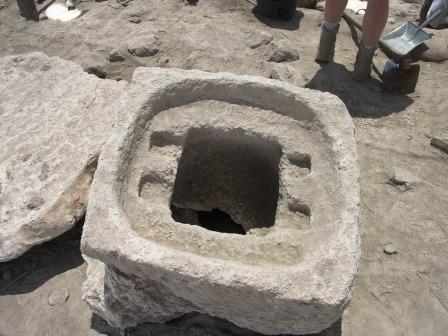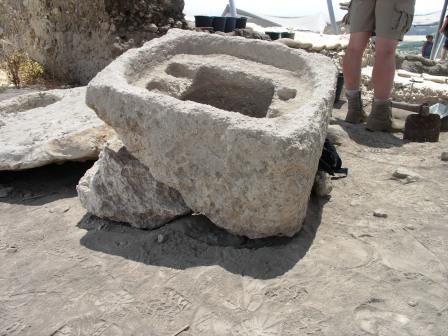by John Strong
June 22, 2011
Archaeology is the careful practice of destruction. This is the reason why archaeology is not really a hard science, but something of a mixture of art and science. For once a wall, floor, or deposit of debris is excavated, it is destroyed and it cannot be re-excavated by someone else to check the details. And so, to understand an ancient wall or artifact, the archaeologist has to remove it or tear it down, and if that does not reveal its secrets, well, the opportunity has been lost.
I suppose that is the “glass half empty” assessment of things. The glass half full perspective is that excavating and removing truly is revelatory. We had a great example of this on the tel today.
In 2006, we excavated all around a wall, which we affectionately numbered “W21017.” At the end of it, we found a huge pillar made of stone, which we identified as “L52026.”. So, for five years, we have been looking at this wall and this pillar, knowing that one of these days, we would have to tear down this wall and—ugh!—pull out that pillar base. Today was the day.
So, we pulled down the wall, stone by stone, and then we got a team of our biggest volunteers to somehow haul that thing out of the square. But when we turned it over—shazzam (please insert your own favorite word expressing surprise)—we saw that this “pillar” was, before becoming a part of a wall, also an olive oil press vat. Suddenly, a lot of things made sense.

First, we had known that there was some type of an olive oil production operation that went on in this area in the past, because we have seen other types of bins, pressing stones, weights, and other hints. But we wondered why there was not a vat in the area; those things are too big just to lose. Now, that we turned over our “pillar,” we found our vat.
Second, we wondered how wall 21017 fit into this olive oil operation. Now we learned that it did not fit at all, but was built over the olive oil operation once that the ancient Gezerites no longer wanted to use this space for olive oil production. And, also, this information fit other things that we had seen—a cobble stone surface that was associated with the olive oil operation, but which wall 21017 interrupted.
We looked at this stuff for years, asking a lot of questions, but never really understood what we were seeing. Only when we dismantled wall 21017 and removed vat/pillar L52026 did we really understand this part of the history of Gezer. So, archaeology is ultimately about destruction—but at least in this case, that is not such a bad thing.

